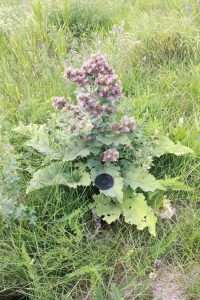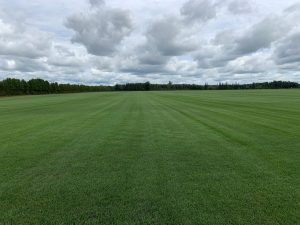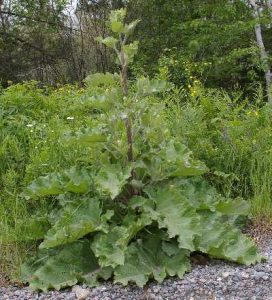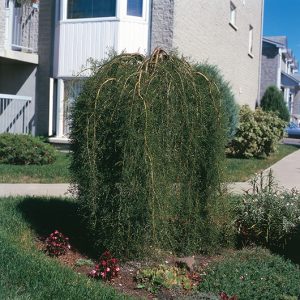
Hi, Dave here from Foxy Gardens in Southwestern Ontario, Canada. If you’ve ever wandered through an Ontario park or trail and returned home with sticky burrs clinging to your clothes or your dog’s fur, you’ve likely encountered burdock—a tall, leafy plant with rough seed heads that latch onto anything they touch.
Here’s a recent encounter we had with a backyard full of 8-foot tall burdock.
While burdock may seem like just another common weed, it poses a serious problem to Ontario’s natural ecosystems. But is burdock officially considered invasive in Ontario?
Yes—burdock is classified as an invasive plant in Ontario, and multiple organizations, including the Ontario Invasive Plant Council (OIPC) and Birds Canada, recognize its ecological threat. Below, we’ll explore what makes burdock invasive, how it spreads, its impact on wildlife, and what’s being done to manage it.
What Is Burdock?
Burdock refers to several species in the Arctium genus, most commonly common burdock (Arctium minus), greater burdock (Arctium lappa), and woolly burdock (Arctium tomentosum).

All three are biennial plants, meaning they grow foliage in the first year and flower in the second. They belong to the Asteraceae (daisy) family and are easily recognized by their large, wavy-edged leaves and prickly, rounded burrs that form in late summer.
While native to Europe and Asia, burdock was introduced to North America likely for medicinal or culinary purposes. Burdock root is edible and has a long history in herbal medicine, but when it escapes into wild or unmanaged spaces, it quickly turns into an ecological nuisance.
Why Is Burdock Considered Invasive in Ontario?
A plant is considered invasive when it is non-native, spreads rapidly, and disrupts local ecosystems by outcompeting native species. Burdock fits all three criteria.
1. Non-native to Ontario
Burdock did not evolve within Ontario’s natural environment. As a result, it lacks natural predators or diseases that would otherwise keep it in check. Without these ecological constraints, burdock grows unchecked in many disturbed habitats.
2. Aggressive Spreader
Burdock thrives in disturbed soils such as roadsides, ditches, park edges, abandoned lots, and fields. Its seeds are designed to hitchhike: the burrs cling to animals, people, and even equipment, spreading easily over long distances. In urban areas, off-leash dogs are a major contributor to its spread.
3. Outcompetes Native Species
Burdock’s large, dense leaves block sunlight from reaching smaller native plants. Over time, this reduces plant diversity in an area, which in turn affects insects, pollinators, and birds that rely on native plants for survival. A monoculture of burdock may look green and healthy, but it’s a biological desert compared to a mixed native ecosystem.
Impact on Wildlife and Pets
One of the most concerning aspects of burdock’s spread is its harmful effect on wildlife, particularly small birds and mammals.
● Deadly Burrs
The burrs that help burdock spread can be fatal to birds. They easily entangle feathers, particularly on smaller birds like warblers or finches, preventing them from flying or feeding properly. According to Birds Canada, there have been multiple instances where birds have died after becoming stuck in burdock clusters.
● Pet Hazards
Dog owners are often surprised to find their pets covered in burrs after a walk in the park. These seed heads can cause skin irritation, get stuck in fur, and even lead to eye injuries or infections if lodged in sensitive areas. For this reason, the City of Toronto has issued public warnings in the past about burdock infestations in parks.
Community and Government Response
The presence of burdock has prompted action from municipalities, environmental groups, and even individual citizens across Ontario.
● City of Toronto
The City has highlighted burdock as a serious concern in parklands and naturalized areas, often integrating it into larger invasive species removal programs.
● Ontario Invasive Plant Council (OIPC)
The OIPC identifies burdock as a species of concern and provides detailed guides and best management practices for removing or controlling it. Their recommendations typically include:
-
Cutting the plant before it seeds (usually in late summer)
-
Digging out the deep taproot entirely
-
Avoiding mechanical mowing, which can lead to root fragmentation and regrowth
● Volunteer Cleanup Efforts
Community groups and volunteers have taken matters into their own hands. In 2025, for example, a team removed large stands of burdock from Trinity Bellwoods Park in Toronto, as documented by The Narwhal.
These grassroots efforts demonstrate how much of an ongoing issue burdock has become—and how awareness is translating into action.
Should You Remove Burdock From Your Property?
If you find burdock growing in your yard or garden, the answer is simple: yes, remove it. While it might not pose an immediate threat in small numbers, letting it grow unchecked can lead to rapid spread—and you may inadvertently contribute to its spread through seeds.
Here’s how to remove burdock effectively:
-
Dig Out the Taproot: This is the most reliable method. Burdock roots can extend up to 3 or 4 feet, so use a spade or garden fork.
-
Cut Before Seeding: If full removal isn’t possible, cut the plant down before burrs form.
-
Do Not Compost Burrs: Dispose of them in yard waste or trash, not compost, to prevent reseeding.
-
Check Clothing and Pets: If you’ve walked through an area with burdock, inspect yourself and your pets for hitchhiking burrs.
Burdock: Useful, But Not Here
It’s worth acknowledging that burdock isn’t all bad—in the right context. In Japan, for instance, burdock root (known as gobo) is a popular vegetable. Herbalists use it for its potential detoxifying effects, and it even played a role in inspiring Velcro’s invention (Swiss engineer George de Mestral modeled the fastener after burdock burrs).
But in Ontario’s wild spaces, its invasive behavior outweighs its benefits. Like many non-native species, it has no natural checks and balances here. The result is a plant that may appear harmless but causes cascading ecological effects when allowed to spread.
Conclusion
Burdock is indeed an invasive plant in Ontario, and its presence poses risks to both wildlife and native ecosystems. While it may have culinary and medicinal uses, its aggressive spread, ability to dominate disturbed environments, and harmful impact on birds and pets make it a priority for removal and management.
Whether you’re a gardener, a hiker, or a concerned citizen, taking action against burdock helps protect Ontario’s biodiversity. Be vigilant, spread awareness, and—most importantly—don’t let the burrs spread further.






